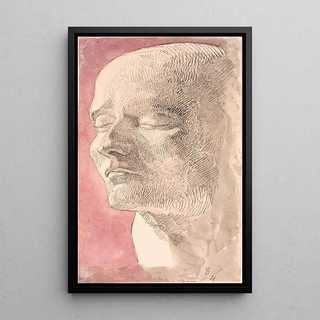Painting Study after the death mask of Napoleon - Johan Thomas Lundbye | Art print


View from behind

Frame (optional)
Study after the death mask of Napoleon: a tribute to memory
The art print "Study after the death mask of Napoleon" by Johan Thomas Lundbye immerses us in an atmosphere that is both solemn and introspective. The composition, centered on the face of the famous emperor, reveals striking details that capture the essence of his personality. The shades of gray and black, accentuated by touches of light, create a powerful contrast, evoking the fragility of life in the face of death. Lundbye's technique, blending realism and sensitivity, invites us to contemplate not only Napoleon's face but also the complex legacy he left behind.
Johan Thomas Lundbye: an artist at the heart of Danish romanticism
Johan Thomas Lundbye, a Danish painter of the 19th century, is often associated with the romantic movement. Trained at the Royal Danish Academy of Fine Arts in Copenhagen, he was influenced by artists such as Caspar David Friedrich. His career, though relatively short, is marked by an exploration of historical and mythological themes, as well as a particular attention to detail. The art print "Study after the death mask of Napoleon" illustrates his interest in iconic figures and their impact on collective imagination. By depicting Napoleon, Lundbye does not merely pay homage to a historical figure but also questions the notions of memory and identity.
A decorative piece with multiple assets
The reproduction of "Study after the death mask of Napoleon" is a decorative item that will enhance your interior, whether in a living room, office, or bedroom. Its print quality and fidelity of details make this canvas a true aesthetic asset, bringing a touch of history and reflection to your decor. By choosing this art print, you opt for a piece that sparks curiosity and conversation, while adding a note of sophistication to your space. This reproduction is much more than a simple decorative element; it is an invitation to explore the past and reflect on the figures who have shaped our world.

Matte finish

View from behind

Frame (optional)
Study after the death mask of Napoleon: a tribute to memory
The art print "Study after the death mask of Napoleon" by Johan Thomas Lundbye immerses us in an atmosphere that is both solemn and introspective. The composition, centered on the face of the famous emperor, reveals striking details that capture the essence of his personality. The shades of gray and black, accentuated by touches of light, create a powerful contrast, evoking the fragility of life in the face of death. Lundbye's technique, blending realism and sensitivity, invites us to contemplate not only Napoleon's face but also the complex legacy he left behind.
Johan Thomas Lundbye: an artist at the heart of Danish romanticism
Johan Thomas Lundbye, a Danish painter of the 19th century, is often associated with the romantic movement. Trained at the Royal Danish Academy of Fine Arts in Copenhagen, he was influenced by artists such as Caspar David Friedrich. His career, though relatively short, is marked by an exploration of historical and mythological themes, as well as a particular attention to detail. The art print "Study after the death mask of Napoleon" illustrates his interest in iconic figures and their impact on collective imagination. By depicting Napoleon, Lundbye does not merely pay homage to a historical figure but also questions the notions of memory and identity.
A decorative piece with multiple assets
The reproduction of "Study after the death mask of Napoleon" is a decorative item that will enhance your interior, whether in a living room, office, or bedroom. Its print quality and fidelity of details make this canvas a true aesthetic asset, bringing a touch of history and reflection to your decor. By choosing this art print, you opt for a piece that sparks curiosity and conversation, while adding a note of sophistication to your space. This reproduction is much more than a simple decorative element; it is an invitation to explore the past and reflect on the figures who have shaped our world.
12,34 €






